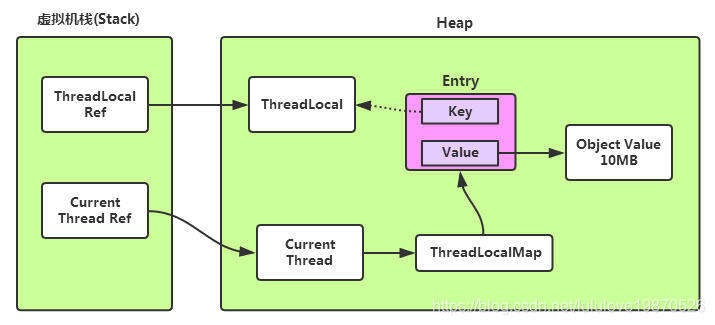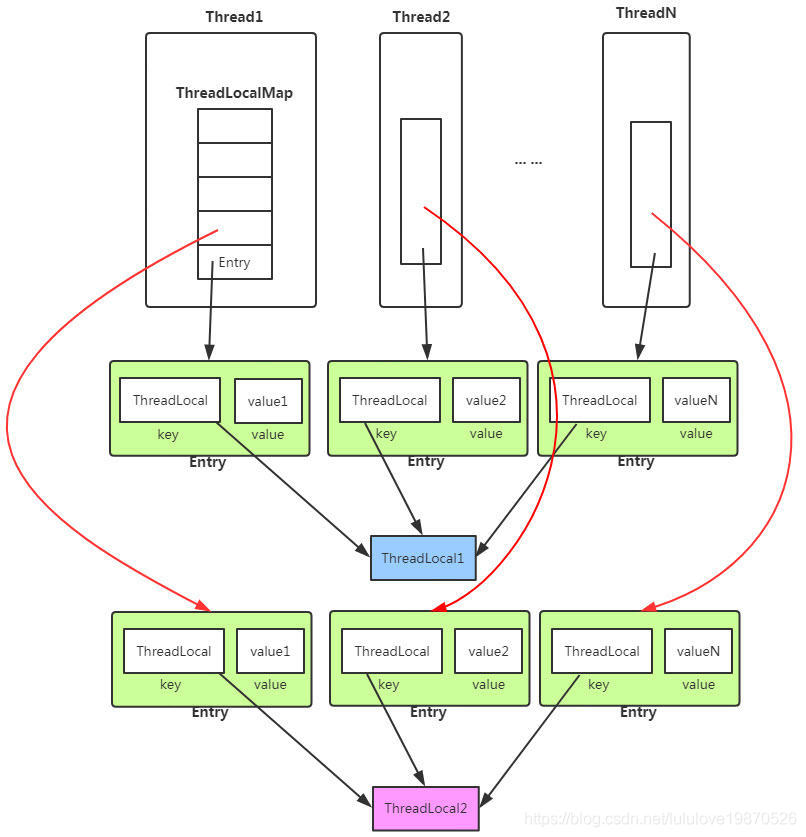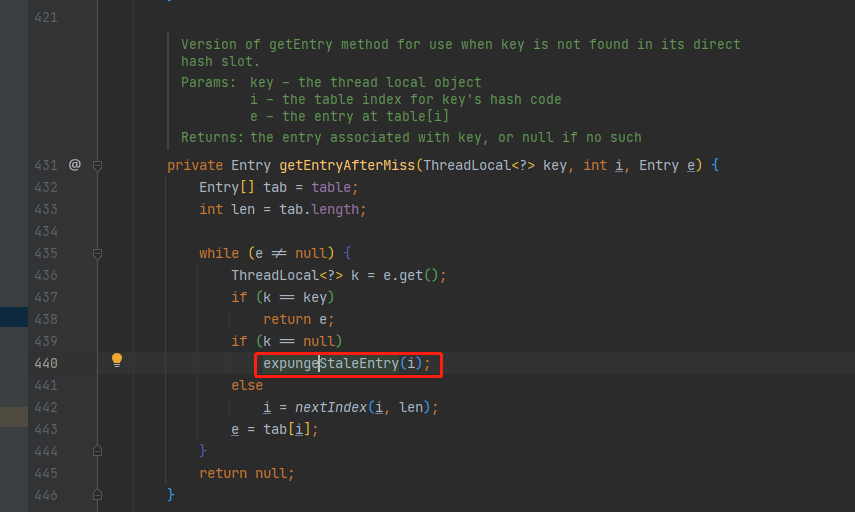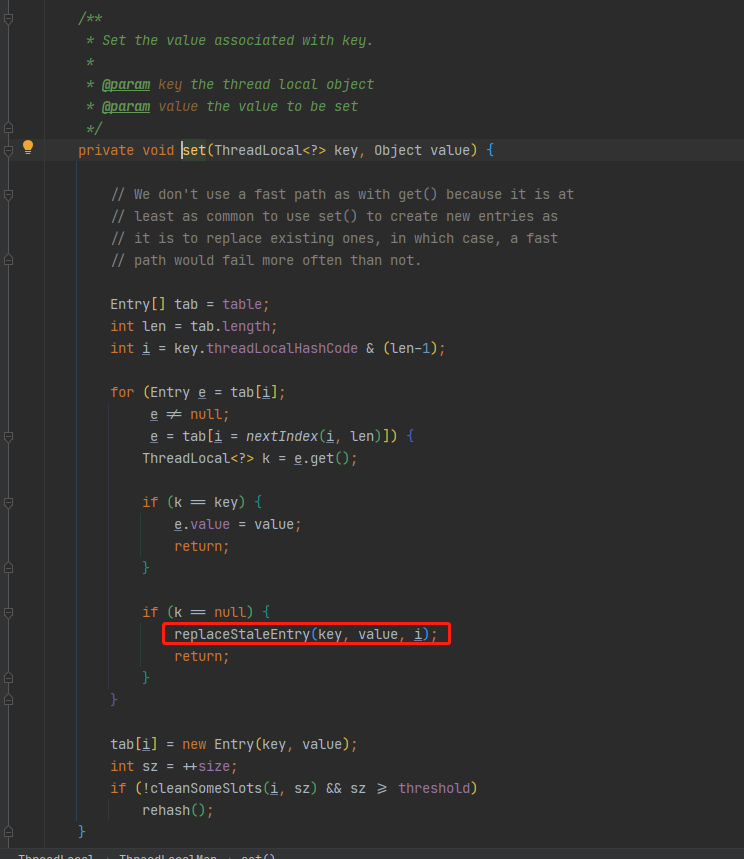原理图
ThreadLocalMap
是ThreadLocal中的内部类,key:当前ThreadLocal,value:Entry,也就是ThreadLocal对应的值。
源码:
/*** ThreadLocalMap is a customized hash map suitable only for* maintaining thread local values. No operations are exported* outside of the ThreadLocal class. The class is package private to* allow declaration of fields in class Thread. To help deal with* very large and long-lived usages, the hash table entries use* WeakReferences for keys. However, since reference queues are not* used, stale entries are guaranteed to be removed only when* the table starts running out of space.*/static class ThreadLocalMap {/*** The entries in this hash map extend WeakReference, using* its main ref field as the key (which is always a* ThreadLocal object). Note that null keys (i.e. entry.get()* == null) mean that the key is no longer referenced, so the* entry can be expunged from table. Such entries are referred to* as "stale entries" in the code that follows.*/static class Entry extends WeakReference<ThreadLocal<?>> {/** The value associated with this ThreadLocal. */Object value;Entry(ThreadLocal<?> k, Object v) {super(k);value = v;}}/*** The initial capacity -- MUST be a power of two.*/private static final int INITIAL_CAPACITY = 16;/*** The table, resized as necessary.* table.length MUST always be a power of two.*/private Entry[] table;/*** The number of entries in the table.*/private int size = 0;/*** The next size value at which to resize.*/private int threshold; // Default to 0/*** Set the resize threshold to maintain at worst a 2/3 load factor.*/private void setThreshold(int len) {threshold = len * 2 / 3;}/*** Increment i modulo len.*/private static int nextIndex(int i, int len) {return ((i + 1 < len) ? i + 1 : 0);}/*** Decrement i modulo len.*/private static int prevIndex(int i, int len) {return ((i - 1 >= 0) ? i - 1 : len - 1);}/*** Construct a new map initially containing (firstKey, firstValue).* ThreadLocalMaps are constructed lazily, so we only create* one when we have at least one entry to put in it.*/ThreadLocalMap(ThreadLocal<?> firstKey, Object firstValue) {table = new Entry[INITIAL_CAPACITY];int i = firstKey.threadLocalHashCode & (INITIAL_CAPACITY - 1);table[i] = new Entry(firstKey, firstValue);size = 1;setThreshold(INITIAL_CAPACITY);}
从代码中,可以看到ThreadLocalMap的Entry继承了WeakReference。
set
//ThreadLocal set
public void set(T value) {
Thread t = Thread.currentThread();
ThreadLocalMap map = getMap(t);
if (map != null)
map.set(this, value);
else
createMap(t, value);
}
/**
* Get the map associated with a ThreadLocal. Overridden in
* InheritableThreadLocal.
* @param t the current thread
* @return the map
*/
ThreadLocalMap getMap(Thread t) {
return t.threadLocals;
}
public class Thread implements Runnable {
/* ThreadLocal values pertaining to this thread. This map is maintained
* by the ThreadLocal class. */
ThreadLocal.ThreadLocalMap threadLocals = null;
//...
}
/**
* Create the map associated with a ThreadLocal. Overridden in
* InheritableThreadLocal.
*
* @param t the current thread
* @param firstValue value for the initial entry of the map
*/
void createMap(Thread t, T firstValue) {
t.threadLocals = new ThreadLocalMap(this, firstValue);
}
/************************** ThreadLocalMap *************************/
/**
* Set the value associated with key.
*
* @param key the thread local object
* @param value the value to be set
*/
private void set(ThreadLocal<?> key, Object value) {
// We don't use a fast path as with get() because it is at
// least as common to use set() to create new entries as
// it is to replace existing ones, in which case, a fast
// path would fail more often than not.
Entry[] tab = table;
int len = tab.length;
int i = key.threadLocalHashCode & (len-1);
for (Entry e = tab[i];
e != null;
e = tab[i = nextIndex(i, len)]) {
ThreadLocal<?> k = e.get();
if (k == key) {
e.value = value;
return;
}
if (k == null) {
replaceStaleEntry(key, value, i);
return;
}
}
tab[i] = new Entry(key, value);
int sz = ++size;
if (!cleanSomeSlots(i, sz) && sz >= threshold)
rehash();
}
//hash冲突的时候如何处理
private static int nextIndex(int i, int len) {
return ((i + 1 < len) ? i + 1 : 0);
}
//扩容
private void rehash() {
expungeStaleEntries();
// Use lower threshold for doubling to avoid hysteresis
if (size >= threshold - threshold / 4)
resize();
}
private void resize() {
Entry[] oldTab = table;
int oldLen = oldTab.length;
int newLen = oldLen * 2;
Entry[] newTab = new Entry[newLen];
int count = 0;
for (int j = 0; j < oldLen; ++j) {
Entry e = oldTab[j];
if (e != null) {
ThreadLocal<?> k = e.get();
if (k == null) {
e.value = null; // Help the GC
} else {
int h = k.threadLocalHashCode & (newLen - 1);
while (newTab[h] != null)
h = nextIndex(h, newLen);
newTab[h] = e;
count++;
}
}
}
setThreshold(newLen);
size = count;
table = newTab;
}
hash冲突的解决方法
和HashMap的最大的不同在于,ThreadLocalMap结构非常简单,没有next引用,也就是说ThreadLocalMap中解决Hash冲突的方式并非链表的方式,而是采用**线性探测的方式**,所谓线性探测,就是根据初始key的hashcode值确定元素在table数组中的位置,如果发现这个位置上已经有其他key值的元素被占用,则利用固定的算法寻找一定步长的下个位置,依次判断,直至找到能够存放的位置。
扩容
扩容的时机:size > 3/4的阀值
数组长度增长为原来的两倍。
get
public T get() {
Thread t = Thread.currentThread();
ThreadLocalMap map = getMap(t);
if (map != null) {
ThreadLocalMap.Entry e = map.getEntry(this);
if (e != null) {
@SuppressWarnings("unchecked")
T result = (T)e.value;
return result;
}
}
return setInitialValue();
}
private Entry getEntry(ThreadLocal<?> key) {
int i = key.threadLocalHashCode & (table.length - 1);
Entry e = table[i];
if (e != null && e.get() == key)
return e;
else
return getEntryAfterMiss(key, i, e);
}
private Entry getEntryAfterMiss(ThreadLocal<?> key, int i, Entry e) {
Entry[] tab = table;
int len = tab.length;
while (e != null) {
ThreadLocal<?> k = e.get();
if (k == key)
return e;
if (k == null)
//去除null
expungeStaleEntry(i);
else
i = nextIndex(i, len);
e = tab[i];
}
return null;
}
remove
public void remove() {
ThreadLocal.ThreadLocalMap m = getMap(java.lang.Thread.currentThread());
if (m != null)
m.remove(this);
}
private void remove(ThreadLocal<?> key) {
ThreadLocal.ThreadLocalMap.Entry[] tab = table;
int len = tab.length;
int i = key.threadLocalHashCode & (len-1);
//只所以用for循环查找key,是因为要考虑hash冲突的情况
for (ThreadLocal.ThreadLocalMap.Entry e = tab[i];
e != null;
e = tab[i = nextIndex(i, len)]) {
if (e.get() == key) {
e.clear();
expungeStaleEntry(i);
return;
}
}
}
public void clear() {
this.referent = null;
}
内存泄露
ThreadLocal的核心机制
每个Thread内部维护着一个ThreadLocalMap,它是一个Map。这个映射表的Key是一个弱引用,其实就是ThreadLocal本身,Value是真正存的线程变量Object。<br /> 也就是说ThreadLocal本身并不真正存储线程的变量值,它只是一个工具,用来维护Thread内部的Map,帮助存和取。所以对于不同的线程,每次获取副本值时,别的线程并不能获取到当前线程的副本值,形成了副本的隔离,互不干扰。
根本原因
ThreadLocal 本身并不存储值,它只是作为一个 key保存到ThreadLocalMap中,但是这里要注意的是它作为一个key用的是弱引用,因为没有强引用链,弱引用在GC的时候可能会被回收。这样就会在ThreadLocalMap中存在一些key为null的键值对(Entry)。因为key变成null了,我们是没法访问这些Entry的,但是这些Entry本身是不会被清除的,为什么呢?因为存在一条强引用链。即线程本身->ThreadLocalMap->Entry也就是说,恰恰我们在使用线程池的时候,线程使用完了是会放回到线程池循环使用的。由于ThreadLocalMap的生命周期和线程一样长,如果没有手动删除对应key就会导致这块内存即不会回收也无法访问,也就是内存泄漏。
其实,ThreadLocalMap的设计中已经考虑到这种情况,也加上了一些防护措施:在 ThreadLocal的get(),set(),remove()【见下】的时候都会清除线程ThreadLocalMap里所有key为null的value。但是这些举动不能保证内存就一定会回收,因为可能这条线程被放回到线程池里后再也没有使用,或者使用的时候没有调用其get(),set(),remove()方法。
内存泄漏归根结底是由于ThreadLocalMap的生命周期跟Thread一样长
如何避免
调用ThreadLocal的get()、set()方法后再调用remove方法,将Entry节点和Map的引用关系移除,这样整个Entry对象在GC Roots分析后就变成不可达了,下次GC的时候就可以被回收。<br /> 如果使用ThreadLocal的set方法之后,没有显示的调用remove方法,就有可能发生内存泄露,所以养成良好的编程习惯十分重要,使用完ThreadLocal之后,记得调用remove方法。<br /> 在不使用线程池的前提下,即使不调用remove方法,线程的"变量副本"也会被gc回收,即不会造成内存泄漏的情况。
jdk本身的防护措施
get
set
remove
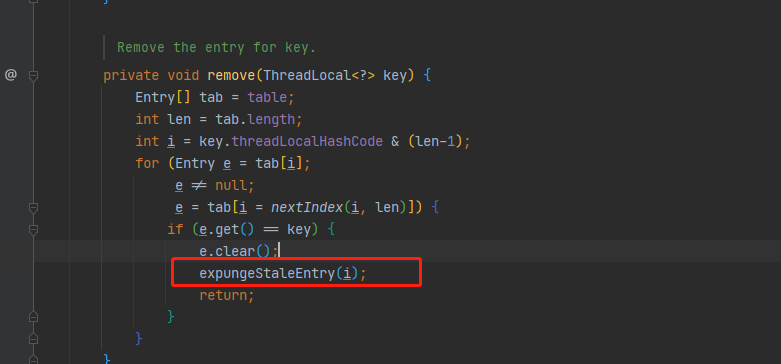
参照:https://blog.csdn.net/lululove19870526/article/details/83688863
